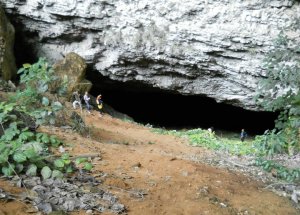DENR declares
Sohoton and Calbiga as class II caves
By Philippine Information
Agency (PIA 8)
May 10, 2013
TACLOBAN CITY, Leyte – The
Department of Environment and Natural Resources has classified as
class II caves the Langun-Gobingob Caves in Calbiga, Samar and the
Sohoton Caves in Basey, Samar.
 DENR Regional Executive
Director Manolito Ragub said this is in line with the Agency’s bid to
protect, conserve and manage the resources within and outside the
caves, as provided for by DENR Memorandum Circular 2012-03 pursuant to
Republic Act No. 9072 otherwise known as the National Caves and Cave
Resources Management and Protection Act.
DENR Regional Executive
Director Manolito Ragub said this is in line with the Agency’s bid to
protect, conserve and manage the resources within and outside the
caves, as provided for by DENR Memorandum Circular 2012-03 pursuant to
Republic Act No. 9072 otherwise known as the National Caves and Cave
Resources Management and Protection Act.
RED Ragub said that
Langun-Gobingob and Sohoton Caves shall be under the administrative
jurisdiction of the DENR in coordination with the Department of
Tourism, National Museum of the Philippines, National Historical
Institute, municipal local government of Calbiga and Basey, Samar,
stakeholders from the academe, Non-Government Organizations, and other
government agencies.
“However, the DENR may opt
to delegate the management of the caves to the LGUs, or other
interested parties consistent with the Public Private Partnership
policy of the Aquino Administration,” RED Ragub said.
RED Ragub informed that
Class II caves have “hazardous conditions and contain sensitive
geological, archaeological, cultural, historical and biological values
or high quality eco-systems. Such caves are open to experienced
spelunkers or caving enthusiasts and guided visits, although some
portions may be closed seasonally or permanently for conservation
purposes.
Class I caves, on the other
hand, are those with delicate and fragile geological formations,
threatened species, archaeological and paleontological values and
extremely hazardous conditions. Only activities for mapping,
photography, educational and scientific purposes are allowed in these
caves.
Meanwhile, Class III caves
are generally safe for inexperienced visitors, with no known
threatened species living in them, nor any archaeological, geological,
historical and cultural values. Economic activities such as collection
of guano and edible birds’ nests, are allowed in these caves.
Moreover, it was learned
that pursuant to RA 9072, a management plan is being prepared for each
cave to consider all ecotourism, scientific, educational and economic
activities, as well as monitoring and reclassification in the areas.
Classification of caves
shall be a continuing process until such time that the caves in the
country are all classified, RED Ragub said.